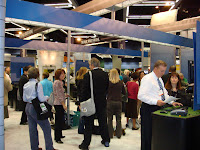 I recently read a short article from the October 13th issue of Time magazine titled "A Brief History of Bracelets" and it fascinated me. The article mentioned many types of bracelets including stainless steel, black metal, bronze metal and rubber silicone. Since I wear a rubber silicone bracelet myself, I figured I provide you some history on bracelets.
I recently read a short article from the October 13th issue of Time magazine titled "A Brief History of Bracelets" and it fascinated me. The article mentioned many types of bracelets including stainless steel, black metal, bronze metal and rubber silicone. Since I wear a rubber silicone bracelet myself, I figured I provide you some history on bracelets.Memorial bracelets have been around since the Vietnam War when a student group, Voices in Vital America (VIVA) began a campaign on behalf of missing American soldiers and prisoners of war using silver bands with soldier information imprinted on them. Senators Barack Obama and John McCain both wore stainless steel bracelets during the Sept 26th Presidential Debate.
Rubber bracelets originated as a punk rock anti-fashion statement when punks would put black rubber o-rings around their wrists and wear them as bracelets in the late 70's and early 80's because the rubber had practically no value compared to traditional jewelry materials. Madonna and Cindy Lauper helped with mainstream popularity in the 80's when they wore o-rings (often in many colors) in their videos and performances.
In the late 90's, the colorful o-rings (or jelly bracelets) reemerged among trendy youth and got some bad press when a rumor scared many parents decreeing that the different colors of the bracelets represented different sexual acts one was willing to perform. Later into the 90's, Rubber Band Bracelets became popular after people would take the thick rubber bands that you get wrapped around broccoli and asparagus at the grocery store and wear them as bracelets. Some companies began making and selling these types of rubber band bracelets printed with a variety of commercial messages although the trend didn't last very long.
The Rubber Band Bracelet trend did last long enough for NBA players to start sporting them and Nike with their keen eye on basketball fashion improved the trend by using the silicone rubber they previously used on sports watch bands and created the Nike Baller ID Band Bracelets. These bracelets came in specific team colors and had sports messages embossed or imprinted into the rubber which many NBA players wore on and off the court.
The first consciousness wristband was shaped by the Lance Armstrong Foundation in 2004 which was essentially a Baller ID Band in yellow and imprinted with "LiveStrong", the motto of Lance Armstrong's foundation for cancer research. The bracelets were sold for $1 each to raise money for cancer research.
Rubber silicone bracelets are even more popular today as many other charities, organizations, schools and accessories producers create them in a wide array of colors and with all kinds of messages, some just for fun. Below are some of the more popular representations:
- Red: Usually for HIV AIDS, Diabetes and Heart Disease awareness and prevention.
- Orange: Signify support for Multiple Sclerosis, American Cancer Society, Asperger's Syndrome and The American Society for the Prevention of Cruelty to Animals (ASPCA).
- Yellow: Lance Armstrong's support for general Cancer research and support for our troops.
- Green: Ecology support, Leukemia, Muscular Dystropy and Kidney Disease awareness in addition to Darfur awareness.
- Blue: Autism, Crohn's disease, Fighting Childhood Bullying in the UK, Violence and Child Abuse prevention and Cystic Fibrosis.
- Purple: Alheimer's, Lupus and Domestic Violence awareness.
- White: Anti-poverty and to support Christian themes.
- Black: Melanoma research and Anti-Racism messages in UK (Black and White together).
- Pink: Breast Cancer research.
- Other: Red, White and Blue for American Pride, Rainbow for Gay Pride, Camouflage for troop support and multicolored for major NBA and MLB teams.
Now that you see how popular these rubber silicone bracelets are, you can decide for yourself if you'd like to jump on the bandwagon whether for fun or to show support. My challenge to you is to guess which band I personally wear on an everyday basis.
Ciao,
Vinnie



















 Another method for creating a widget as a distributable object is the use of an object generator. They have many names, but do the same job…
Another method for creating a widget as a distributable object is the use of an object generator. They have many names, but do the same job…




 Let's say that you also have a moveable block of web functionality that when you use it it prompts you to send some of the fun you are having in your friends' directions. "Select all of the friends you want to _______." This would fall into the category of friend spamming. Now that you know the difference, how are social utilities like Facebook battling the attack of the time-killing (and email clogging) apps?
Let's say that you also have a moveable block of web functionality that when you use it it prompts you to send some of the fun you are having in your friends' directions. "Select all of the friends you want to _______." This would fall into the category of friend spamming. Now that you know the difference, how are social utilities like Facebook battling the attack of the time-killing (and email clogging) apps?


